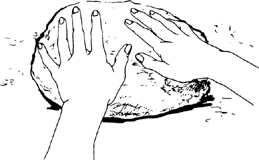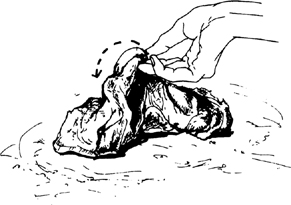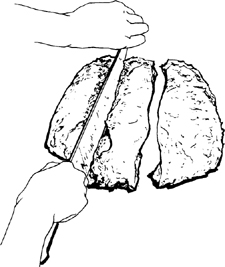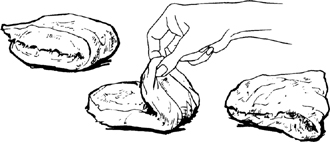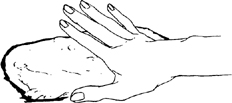Mastering the Art of French Cooking, Volume 2 (27 page)
Read Mastering the Art of French Cooking, Volume 2 Online
Authors: Julia Child

| Lightly flour the palms of your hands and |
Lift a corner of the near side and flip it down onto the far side. |
|
Slip the sides of your hands under the dough and return it to the bowl. Cover and let rise again, this time to not quite triple, but again until it is dome-shaped and light and spongy when touched.
(*)
DELAYED ACTION
: See chart at end of recipe.
5)
Cutting and resting dough before forming loaves
Loosen dough all around inside of bowl and turn out onto a lightly floured surface. Because of its two long rises, the dough will have much more body. If it seems damp and sweaty, sprinkle lightly with flour.
| Making clean, sure cuts with a large knife or a scraper, divide dough into 3 equal pieces for long loaves |
After you have cut each piece, lift one end and flip it over onto the opposite end to fold the dough in two; |
|
While the dough is resting, prepare the rising surface: smooth the canvas or linen toweling on a large tray or baking sheet, and rub flour thoroughly into the entire surface of the cloth to prevent the dough from sticking.
6)
Forming loaves—la tourne; la mise en forme des pâtons
Because French bread stands free in the oven and is not baked in a pan, it has to be formed in such a way that the tension of the coagulated gluten cloak on the surface will hold the dough in shape. Following are illustrated directions for the familiar long loaf—the
bâtards
(baked size 16 by 3 inches); other shapes are described and illustrated at the end of the recipe.
Baguettes
are much too long for home ovens.
After the 3 pieces of dough have rested 5 minutes, form one piece at a time, keeping the remaining ones covered.
| Working rapidly, turn the dough upside down on a lightly floured kneading surface and |
